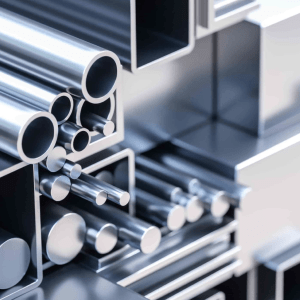
Selecting the right metal is a critical step in assuring the success of any project. At Alafnan Metals, we recognise that aluminum and steel have particular features that make them excellent for certain applications. This guide will provide you with the information you need to make an informed decision about which metal is best suited for your project.
Steel is well known for its tremendous strength and durability. Consider a large bridge across a river; steel provides unwavering stability. Steel’s superior strength makes it the chosen material for projects requiring large load-bearing capability, such as bridges, buildings, and industrial equipment. Imagine
enormous towers rising towards the sky, their unyielding structures carved from steel. This incredible ability to endure enormous weight and pressure ensures
that innumerable structures remain stable and secure for generations ahead. However, its strong nature results in additional weight, which might cause logistical issues during shipment and installation. Despite this, it remains the preferred material for projects that require unchanging strength and long-lasting
reliability.
Aluminum is an attractive choice because of its lightweight and flexibility. Consider a sleek aeroplane soaring through the skies, with a lightweight aluminum frame. This makes aluminum excellent for tasks that require weight reduction, such as aircraft building, cars, and architectural cladding. Furthermore, aluminum has a natural resistance to corrosion, which eliminates the need for further coatings in many cases. This leads to decreased long-term maintenance expenses. However, its strength is inferior to steel, rendering it unsuitable for heavy-duty load-bearing applications.
Strength: While aluminum shines in applications where weight reduction is critical, steel is king in resisting large loads.
Weight: Steel’s higher density than aluminum affects transportation and installation techniques.
Corrosion Resistance: Steel requires the application of protective coatings. while aluminum is naturally corrosion resistant.
Formability: While aluminum shows excellent malleability, which makes shaping during manufacturing easier, steel is somewhat rigid.
Cost: While the manufacturing process for aluminum can reduce its cost, steel is usually more affordable. Still, aluminum’s remarkable recyclability pays long-term financial rewards.
Aesthetics: Steel has a classic, industrial look, while aluminum radiates sleek modernism. Both materials can be polished or painted to suit the project’s
concept.
The ultimate choice between aluminum and steel depends on the particular needs of your project. Here’s a brief decision tree to assist you with the selection
process:
Prioritising Strength and Load Bearing Capacity? Steel is your champion. Prioritizing Weight Reduction and Corrosion Resistance? Aluminum is your champion. Does the project require formability and shaping? Aluminium provides additional flexibility. Are you looking for a cost-effective solution for large projects? Steel might be the
more cost-effective option.